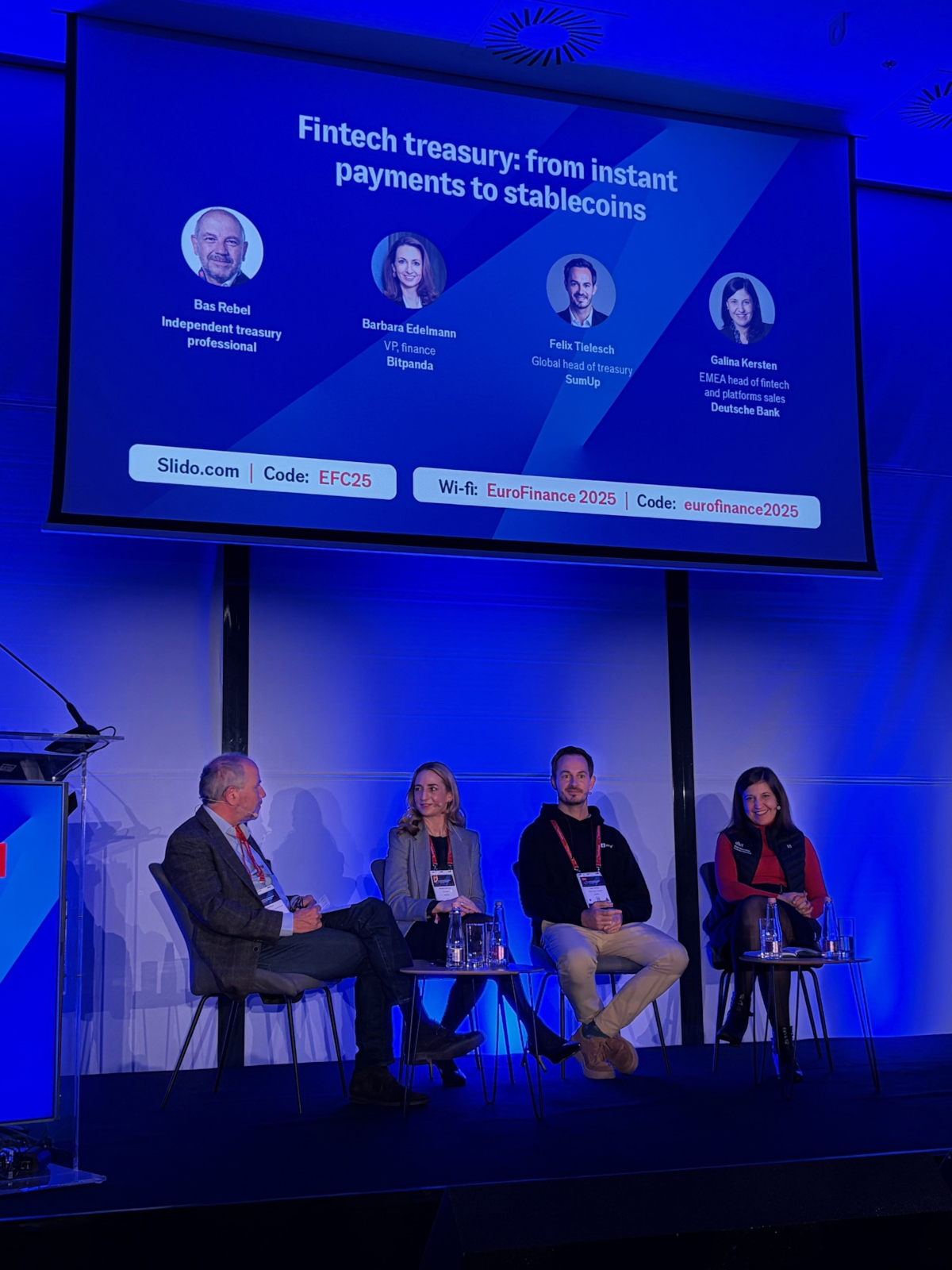24 November 2025
As real-time payments, APIs, and digital assets transform how money moves, corporates have to keep up. Reporting from EuroFinance 2025, flow explores how fintech companies SumUp and Bitpanda demonstrate treasury’s power as both enabler and catalyst of this transformation
MINUTES min read
According to Boston Consulting Group’s Global Payments Report 2025, the payments industry is entering a decisive new phase, where what was once steady evolution is giving way to wholesale, structural change.1 Established players must adapt their business and operating models fundamentally – and swiftly – to keep pace with more agile fintechs, it argues. Sitting behind this fintech agility is not just technology – treasury has increasingly become a strategic enabler of transformation too. Fintechs, with their digital-first infrastructures, are demonstrating what that future can look like in practice.2
At the 2025 EuroFinance International Treasury Management conference in Budapest, treasurers from SumUp – a leading global payments platform serving millions of small merchants – and Vienna-based Bitpanda – one of Europe’s largest and fastest-growing digital asset investment platforms that has launched in the UK3 – joined Deutsche Bank’s session, Fintech treasury: from instant payments to stablecoins, to reveal how fintechs are reshaping payments from within.
Their experiences offer valuable lessons for all corporate treasurers on balancing agility with control, embedding instant payments, and exploring stablecoins as a new opportunity to facilitate real-time value transfer.
Treasury at fintechs: balancing agility and stability
Treasurers at the more fast-moving fintechs are often a couple of years ahead of the curve when it comes to adopting emerging technologies in areas such as real-time payments, banking, application programming interfaces (APIs), digital wallets, stablecoins, and cross-border transactions. In the panel, which was moderated by the independent treasury professional Bas Rebel, the participants discussed how a new generation of digital firms are reshaping cash and liquidity management.
“We are not just digital-first, we are digital-only”
As fintechs scale up, their treasury functions are evolving from supportive to strategic roles. This is partly because, unlike many traditional corporates, fintech treasuries are digitally native, embedded in real-time business models, and built around instant visibility of liquidity across entities and jurisdictions.
Barbara Edelmann, VP Finance at Bitpanda, described how this mindset is reflected in culture as much as in systems: “We are not just digital-first, we are digital-only. This is deeply ingrained in our DNA, our culture, our leadership, and is built into how we handle our treasury operations on a day-to-day basis. We think about treasury strategically, in terms of it being a core value driver of the organisation and the strategic pillar of our service offerings.”
In short, the fintechs’ pace of change highlights a different rhythm of execution between the incumbents and ‘disruptors’. “The speed of interaction, the focus on innovation, and the will to succeed are on a different level,” noted Galina Kersten, EMEA Head of Fintech, Platforms & Digital Economy Sales at Deutsche Bank. “A classic corporate can take three months to conduct a request for proposal ‘beauty contest’ and select a bank partner – whereas in the same time a fintech has already conducted 10 30-minute sessions, taken a decision, and started ramping up. The speed of progress is considerably faster.”
However, this agility, the panel agreed, should not come at the expense of prudence. Findings from PwC’s 2025 Global Treasury Survey reinforce that message: while many treasuries are accelerating their adoption of digital tools to improve control and transparency, the most effective ones are coupling this with stronger, more resilient risk frameworks.4 The report notes that cyber security, data integrity and operational continuity remain central treasury priorities, as organisations seek to modernise without compromising stability.
As Edelmann stressed: “In the trust business, moving fast and breaking things is not an option. It’s about not losing the agility, not losing the appetite for innovation and risk, but taking decisions based on calculation. This is where treasury comes into play. To provide the information for management to make those kinds of decisions, to build the models, and do the analysis – especially when working in a regulated environment.”
Fast-paced innovation should not come at the expense of increased risk nor operational instability, agreed Felix Tielesch, Global Head of Treasury at SumUp. “Fail fast, fail often. But do it in a pilot area, where we can monitor the risk and stay very close to the business. We have to oversee things in a very controlled way,” he reflected.

Instant payments: liquidity at the speed of business
As flow highlighted in a May 2024 article titled Three key fintech trends in Europe, SumUp’s collaboration with Deutsche Bank has established it as one of Europe’s most advanced adopters of both instant payments and API-driven automation. The two organisations have partnered to build a real-time payout infrastructure that now covers more than 90% of SumUp’s merchant transactions, allowing merchants to access available funds instantly – even late in the evening or on weekends.
“SumUp has booked every upgrade available – late business hours, late evening payouts, weekend payouts, APIs, push notifications, connections, and so on. It has been a really exciting journey,” explained Kersten. “The greatest advantage is the exceptionally high transparency. At any point in time you know where the payment is, you are notified, and you know exactly when it has been credited. It’s not just about paying instantly; it’s about being informed instantly.”
“We want to provide merchants with liquidity as fast as possible”
For SumUp, the benefits extend far beyond user experience. Instant payments offer full visibility over all relevant liquidity positions and significantly reduce idle cash. “We want to provide merchants with liquidity as fast as possible. Handling card payment brings certain complexity in the payment flow, as several parties are involved including card schemes, acquirers, fintechs and banks. For the merchant a key criterion is speed of payouts of proceeds to receive timely cash flow. This is where we utilise the power of instant payments,” said Tielesch. “Also, from a corporate perspective, it gives us much better insight into our real-time cash. We're not waiting for end-of-day statements, and every euro is put to work for the business and for our merchants.”
This focus on immediacy mirrors a broader shift across treasury. According to the European Association of Corporate Treasurers Treasury Survey 2025,5 real-time reporting and dashboarding rank as the top priority for treasurers over the next two years, closely followed by real-time liquidity and real-time payments and collections. The report concludes that “immediacy and the time factor have become crucial in today’s environment”, underscoring how the need to move in real-time is changing from a differentiator to a baseline expectation.
As Kersten noted, “Speed is no longer a ‘nice to have’. It’s a decisive factor. Consumers’ and small businesses’ experiences with banks and payments providers are increasingly comparable to live streaming or calling an Uber. It’s all happening instantly. We need to prepare for it, build connections, and start moving in that direction.”
Stablecoins: the next frontier for real-time value transfer
Based on current utility, it could be argued that stablecoins pose only a small threat to incumbent payment networks. Yet, as McKinsey highlights in its 2024 report The Stable Door Opens: How Tokenized Cash Enables Next-Gen Payments, the volume of stablecoin transactions has grown exponentially over the past four years, exceeding US$27trn annually.6 If that trajectory continues, stablecoin transactions could surpass traditional payment volumes within the next decade.
This growth, McKinsey observes, originates from the ability of tokenised cash to operate continuously, satisfy demand for instant settlement, and improve operational risk control – attributes that address long-standing pain points for treasurers seeking real-time liquidity. On that basis, McKinsey concludes that any institution engaged in payments activity might want to begin preparing to engage with tokenised cash, while those reliant on legacy systems should start developing the capabilities to support it.
What began as a niche innovation is rapidly developing towards being a strategic consideration for treasurers. Bitpanda, SumUp and their peers are already moving ahead by piloting stablecoin-based solutions to enhance liquidity and settlement speed.
“At Bitpanda, we have two main use cases for stablecoins,” explained Edelmann. “First, they make the whole onboarding experience as smooth as possible for the customer, enabling them to instantly trade once they’re on the platform. Second, in our own trading and hedging operations, stablecoins allow us to instantly move trading values around – like a more traditional cross-border banking network.”
SumUp, is also exploring stablecoins from a treasury angle: “We’re looking at how they can reduce idle cash – exploring how, for example, we could move Bitcoins instantly to a wallet in the US, or to other regions and entities without having too many buffers,” Tielesch said. “It would concentrate cash and create better returns from our own investments.”
“We see ourselves as the trusted partner that bridges the gap between traditional finance and regulated stablecoins”
To integrate wallets and stablecoins into treasury reporting and applications, Tielesch explained that they would have to use “API integrations to add them into the ERP or into the TMS system.” For now, SumUp is treating stablecoins as a separate currency.
For Deutsche Bank, the opportunity lies in bridging traditional and decentralised finance: “One of our key initiatives is to act as the reserve bank for stablecoins – providing reserve accounts to ensure stability and security of deposits held at a global systemically important bank like Deutsche Bank,” Kersten said. “We see ourselves as the trusted partner that bridges the gap between traditional finance and regulated stablecoins.”
While these developments are still in their early stages, the panel consensus indicated that stablecoins could become a complementary layer in the future payments landscape – offering speed, transparency, affordability, and reach beyond domestic instant-payment rails. As moderator Bas Rebel concluded, what we see today in European fintech treasury may well be the blueprint for the next phase of transaction banking.
The 34th annual EuroFinance International Treasury Management conference was held in Budapest from 15-17 October 2025
Sources
1 See bcg.com
2 See A point brought out in flow’s ‘How technology is taking treasury into the boardroom’, based on Crisil Coalition Greenwich research
3 See theblock.co
4 See pwc.com
5 See admin.treasury-management.com
6 See mckinsey.com



